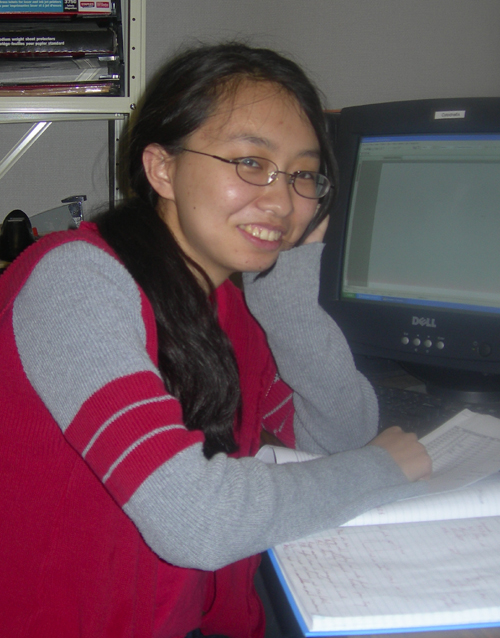Meiqi Guo, Queen’s University

When the summer was over and I came back to Kingston to start 2nd year at Queen’s University, I wanted to volunteer in a lab during the school year to become more familiar with the laboratory environment as at that time, I was considering a future career in research. I really wanted to volunteer in Dr. Holden’s laboratory, which works on finding the genetic basis of ASD, because I was motivated by my positive experiences from the summer. Dr. Holden very kindly accepted me into her lab as a volunteer during the school year, and later on hired me as a summer student.
My summer research experience was really great. The first project that I participated in was the extraction of DNA and RNA, two forms of genetic material, from placental tissue. The placental tissues were frozen in –80ºC liquid nitrogen so it was quite an adventure cutting them and grounding them in preparation for the extractions! The DNA and RNA extracted from the tissue will be used in future studies.
Then I worked on a project with Chris, who is the lab technician, which involved performing genotyping of four different parts of genes on new samples or samples that needed to be repeated. The goal of genotyping is to find out whether one allele, that is, one variation of a gene, may have correlation with the prevalence of ASD. So we would take the DNA samples and use PCR (Polymerase Chain Reaction) to replicate many, many copies of DNA in the region of interest. Then we used enzymes that would cut the DNA in different places depending on the sequence of DNA in that gene. We made gels out of agarose, and ran the cut DNA in these gels with an electric current. The gels had a dye (ethidium bromide) which sticks to the DNA and when we visualize the gels with a special digital camera we are then able to tell what variation of a gene that particular person had based on how far his/her cut DNA traveled in the gel. While I’d learned about genotyping on a theoretical level in my university courses before, I’d never actually performed genotyping in the laboratory setting with real samples so it was a very exciting learning experience for me.
At the end of the summer, I helped Ami, another summer student in the lab, with her experiments. She was using a specialized genotyping machine that we nicknamed “the ABI machine” because its real name was too long to say. This machine allows genotyping to be performed very quickly, although its materials are more expensive and the techniques for this machine are much harder. The machine used plates that had 384 little wells only about 2mm in diameter and it was very challenging work putting DNA samples and other required reagents into these tiny wells with precision, accuracy and speed. Near the end of the summer, however, the lab was very lucky and won in a draw a digital pipette capable of pipetting into 12 wells simultaneously! It was so much easier making the 384 well plates using our new pipette and I made about twenty of those 384-well DNA plates for Patrick, the PhD student in the lab, for his research.
I learned so much about genetic research laboratory techniques in Dr. Holden’s lab and that made my summer research experience really great. But it was also really great in other, unexpected ways. I can’t believe that I met so many inspiring individuals. I met Jim, Dr. Holden’s younger brother who has autism, who is an absolutely amazing person. I worked with Patrick, who is doing his PhD in this field because he is devoted to his little brother, who has ASD. I got to know Heidi, one of the research assistants, through the group lunch breaks. I was really inspired by how she works so hard constantly to provide the best for her son with ASD. I hope that I can be as loving and caring of a mom as she is when I grow up and have children of my own. Most of all though, I was awed by how co-operative and giving the families in the research registry were and how helpful they were to research efforts. They were willing to donate their saliva, cheek swabs, blood… even placental tissue. More significantly, they donated time out of their incredibly busy and hectic lives to participate in research questionnaires and interviews. Their altruism, all for the goal that some wonderful day in the hopefully not so distant future that we will be able to understand ASD at the genetic level, really moved me.
I am sorry to say that I’ve made a decision not to pursue a career in research this August, but rather try instead for a career in medicine. However, I remember Heidi talking about all the challenges and hurdles that individuals with ASD have in terms of accessing proper healthcare because some physicians just don’t have the time to sit down and listen. Therefore, despite that I will not be continuing in the research stream, I will always remember and apply the most important thing that I learned this summer – there is great value and worth in all human beings regardless of their abilities or disabilities. Jim, Heidi’s son, and all the 2000 moms and dads in the research registry with their belief in and love for their son or daughter with ASD taught me that. If I were to be successful in my goal to become a physician some day, I promise to do right. I promise to always treat individuals with ASD or other PDDs with the respect and dignity that they deserve.
| SITE MAP STUDIES |
QUESTIONNAIRES
MY ACCOUNT
CONTACT US
| Q–GLO LOOKING FOR SOMETHING? |





